Fair Work Act (2009): An Analysis of its Impact on Employee Relations
VerifiedAdded on 2023/06/03
|16
|4198
|282
Essay
AI Summary
This essay provides an in-depth analysis of the impact of the Fair Work Act (2009) on employee relations in Australia, reflecting on its economic, political, and social contexts. It examines the role of the Fair Work Commission (FWC) in regulating employment legislation and ensuring minimum conditions and protection for employees. The essay discusses key elements such as dispute resolution, consultation, and flexibility, illustrating how the Act has reshaped the employment relations landscape. It also addresses issues like workplace bargaining, wage disputes, and the importance of strong employee relations for organizational success, drawing on news articles and scholarly sources to support its arguments.
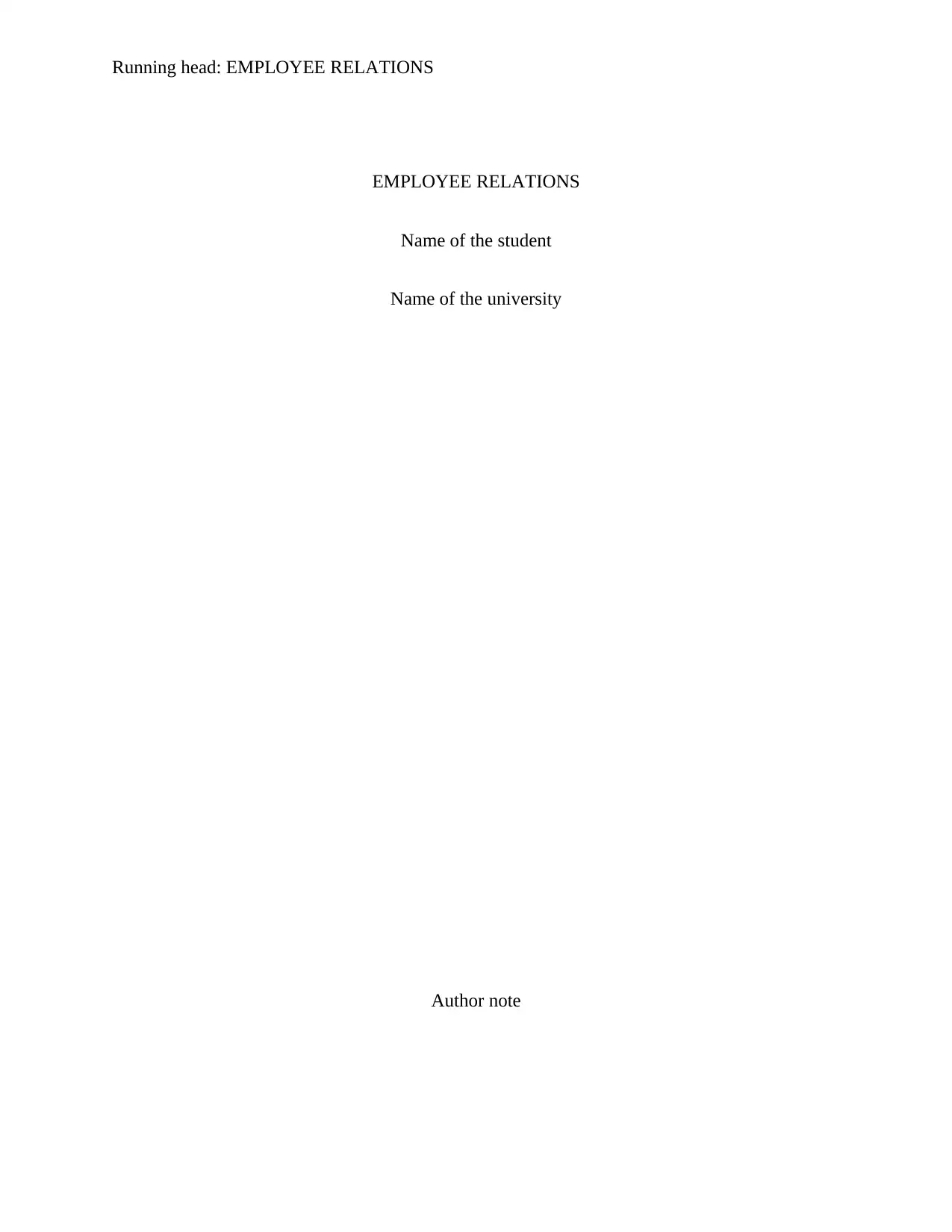
Running head: EMPLOYEE RELATIONS
EMPLOYEE RELATIONS
Name of the student
Name of the university
Author note
EMPLOYEE RELATIONS
Name of the student
Name of the university
Author note
Paraphrase This Document
Need a fresh take? Get an instant paraphrase of this document with our AI Paraphraser
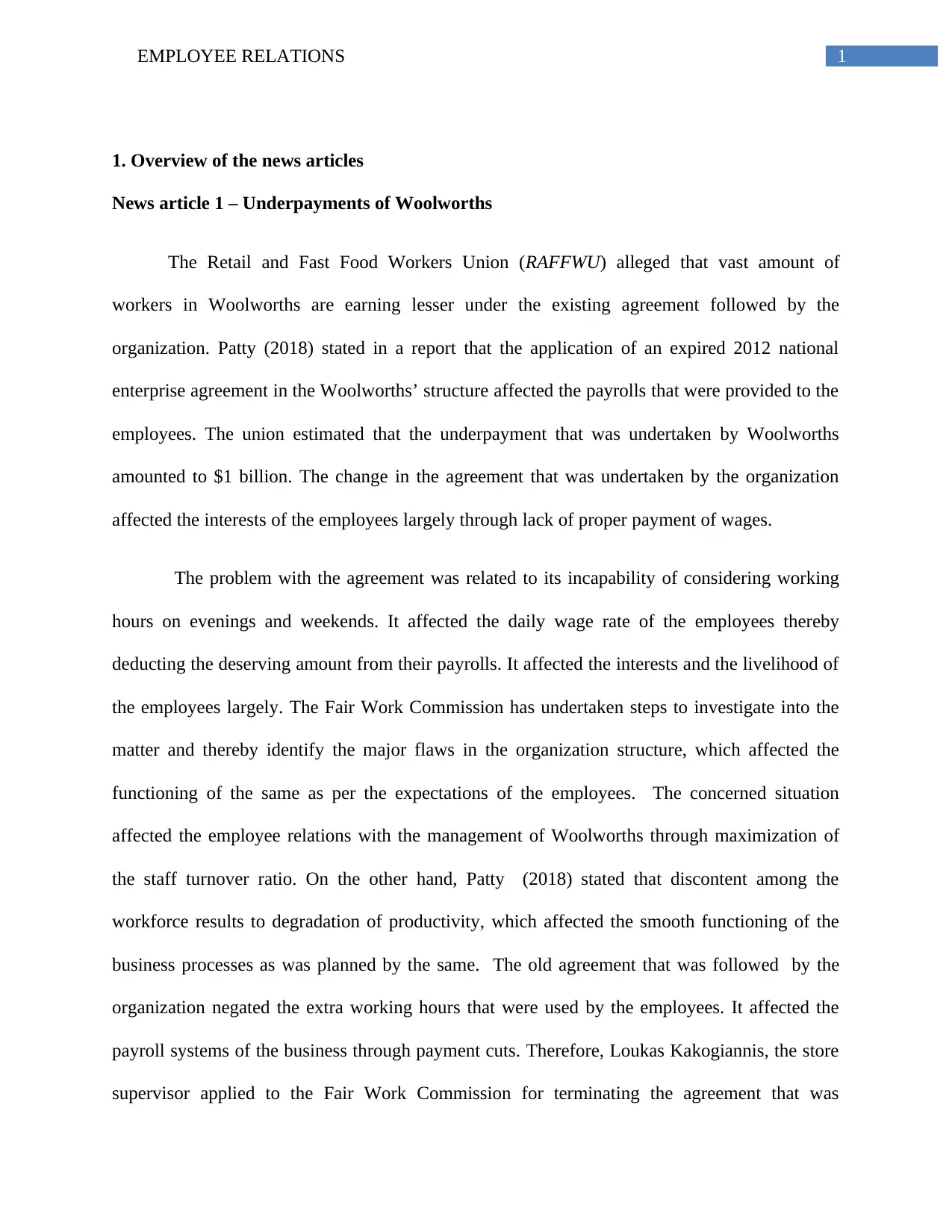
1EMPLOYEE RELATIONS
1. Overview of the news articles
News article 1 – Underpayments of Woolworths
The Retail and Fast Food Workers Union (RAFFWU) alleged that vast amount of
workers in Woolworths are earning lesser under the existing agreement followed by the
organization. Patty (2018) stated in a report that the application of an expired 2012 national
enterprise agreement in the Woolworths’ structure affected the payrolls that were provided to the
employees. The union estimated that the underpayment that was undertaken by Woolworths
amounted to $1 billion. The change in the agreement that was undertaken by the organization
affected the interests of the employees largely through lack of proper payment of wages.
The problem with the agreement was related to its incapability of considering working
hours on evenings and weekends. It affected the daily wage rate of the employees thereby
deducting the deserving amount from their payrolls. It affected the interests and the livelihood of
the employees largely. The Fair Work Commission has undertaken steps to investigate into the
matter and thereby identify the major flaws in the organization structure, which affected the
functioning of the same as per the expectations of the employees. The concerned situation
affected the employee relations with the management of Woolworths through maximization of
the staff turnover ratio. On the other hand, Patty (2018) stated that discontent among the
workforce results to degradation of productivity, which affected the smooth functioning of the
business processes as was planned by the same. The old agreement that was followed by the
organization negated the extra working hours that were used by the employees. It affected the
payroll systems of the business through payment cuts. Therefore, Loukas Kakogiannis, the store
supervisor applied to the Fair Work Commission for terminating the agreement that was
1. Overview of the news articles
News article 1 – Underpayments of Woolworths
The Retail and Fast Food Workers Union (RAFFWU) alleged that vast amount of
workers in Woolworths are earning lesser under the existing agreement followed by the
organization. Patty (2018) stated in a report that the application of an expired 2012 national
enterprise agreement in the Woolworths’ structure affected the payrolls that were provided to the
employees. The union estimated that the underpayment that was undertaken by Woolworths
amounted to $1 billion. The change in the agreement that was undertaken by the organization
affected the interests of the employees largely through lack of proper payment of wages.
The problem with the agreement was related to its incapability of considering working
hours on evenings and weekends. It affected the daily wage rate of the employees thereby
deducting the deserving amount from their payrolls. It affected the interests and the livelihood of
the employees largely. The Fair Work Commission has undertaken steps to investigate into the
matter and thereby identify the major flaws in the organization structure, which affected the
functioning of the same as per the expectations of the employees. The concerned situation
affected the employee relations with the management of Woolworths through maximization of
the staff turnover ratio. On the other hand, Patty (2018) stated that discontent among the
workforce results to degradation of productivity, which affected the smooth functioning of the
business processes as was planned by the same. The old agreement that was followed by the
organization negated the extra working hours that were used by the employees. It affected the
payroll systems of the business through payment cuts. Therefore, Loukas Kakogiannis, the store
supervisor applied to the Fair Work Commission for terminating the agreement that was
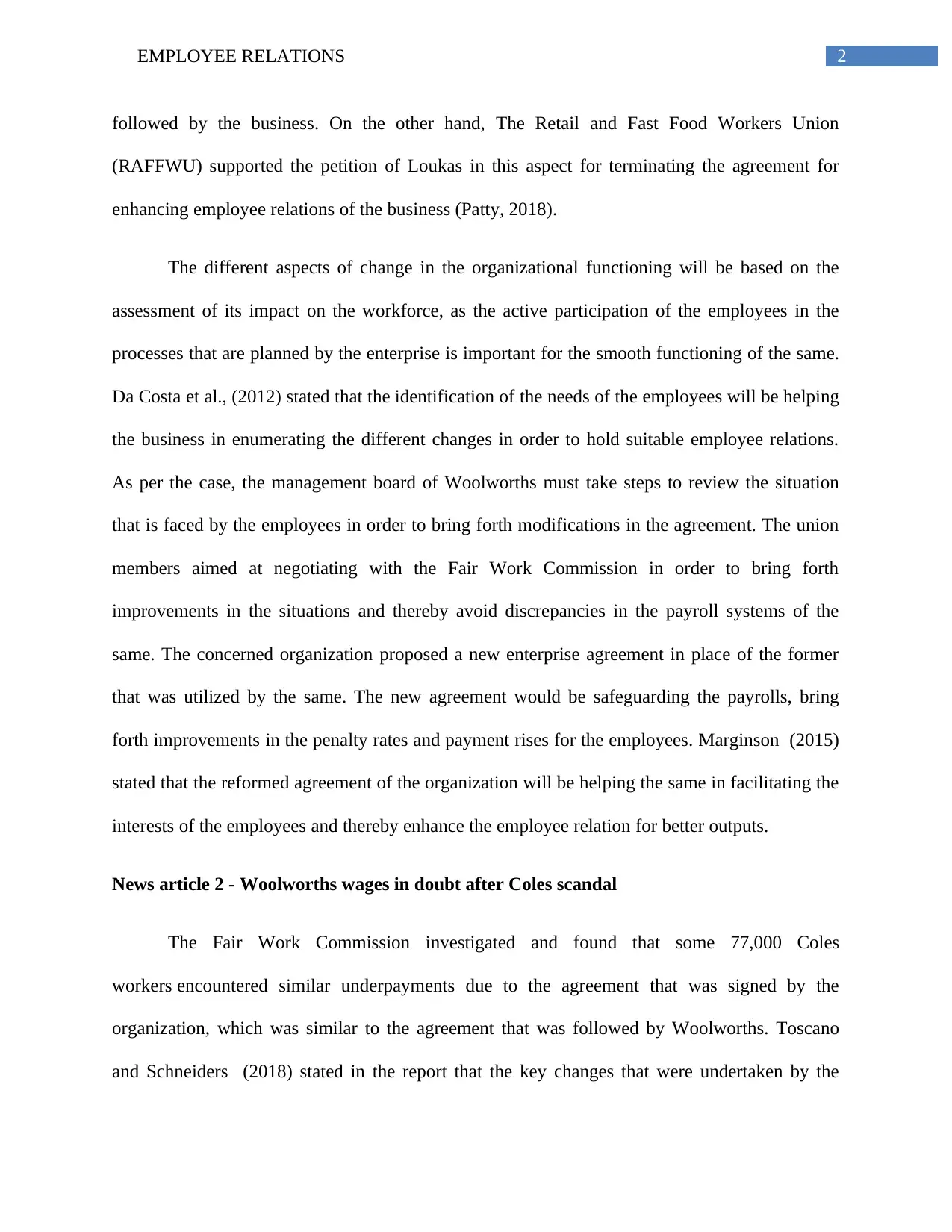
2EMPLOYEE RELATIONS
followed by the business. On the other hand, The Retail and Fast Food Workers Union
(RAFFWU) supported the petition of Loukas in this aspect for terminating the agreement for
enhancing employee relations of the business (Patty, 2018).
The different aspects of change in the organizational functioning will be based on the
assessment of its impact on the workforce, as the active participation of the employees in the
processes that are planned by the enterprise is important for the smooth functioning of the same.
Da Costa et al., (2012) stated that the identification of the needs of the employees will be helping
the business in enumerating the different changes in order to hold suitable employee relations.
As per the case, the management board of Woolworths must take steps to review the situation
that is faced by the employees in order to bring forth modifications in the agreement. The union
members aimed at negotiating with the Fair Work Commission in order to bring forth
improvements in the situations and thereby avoid discrepancies in the payroll systems of the
same. The concerned organization proposed a new enterprise agreement in place of the former
that was utilized by the same. The new agreement would be safeguarding the payrolls, bring
forth improvements in the penalty rates and payment rises for the employees. Marginson (2015)
stated that the reformed agreement of the organization will be helping the same in facilitating the
interests of the employees and thereby enhance the employee relation for better outputs.
News article 2 - Woolworths wages in doubt after Coles scandal
The Fair Work Commission investigated and found that some 77,000 Coles
workers encountered similar underpayments due to the agreement that was signed by the
organization, which was similar to the agreement that was followed by Woolworths. Toscano
and Schneiders (2018) stated in the report that the key changes that were undertaken by the
followed by the business. On the other hand, The Retail and Fast Food Workers Union
(RAFFWU) supported the petition of Loukas in this aspect for terminating the agreement for
enhancing employee relations of the business (Patty, 2018).
The different aspects of change in the organizational functioning will be based on the
assessment of its impact on the workforce, as the active participation of the employees in the
processes that are planned by the enterprise is important for the smooth functioning of the same.
Da Costa et al., (2012) stated that the identification of the needs of the employees will be helping
the business in enumerating the different changes in order to hold suitable employee relations.
As per the case, the management board of Woolworths must take steps to review the situation
that is faced by the employees in order to bring forth modifications in the agreement. The union
members aimed at negotiating with the Fair Work Commission in order to bring forth
improvements in the situations and thereby avoid discrepancies in the payroll systems of the
same. The concerned organization proposed a new enterprise agreement in place of the former
that was utilized by the same. The new agreement would be safeguarding the payrolls, bring
forth improvements in the penalty rates and payment rises for the employees. Marginson (2015)
stated that the reformed agreement of the organization will be helping the same in facilitating the
interests of the employees and thereby enhance the employee relation for better outputs.
News article 2 - Woolworths wages in doubt after Coles scandal
The Fair Work Commission investigated and found that some 77,000 Coles
workers encountered similar underpayments due to the agreement that was signed by the
organization, which was similar to the agreement that was followed by Woolworths. Toscano
and Schneiders (2018) stated in the report that the key changes that were undertaken by the
⊘ This is a preview!⊘
Do you want full access?
Subscribe today to unlock all pages.

Trusted by 1+ million students worldwide
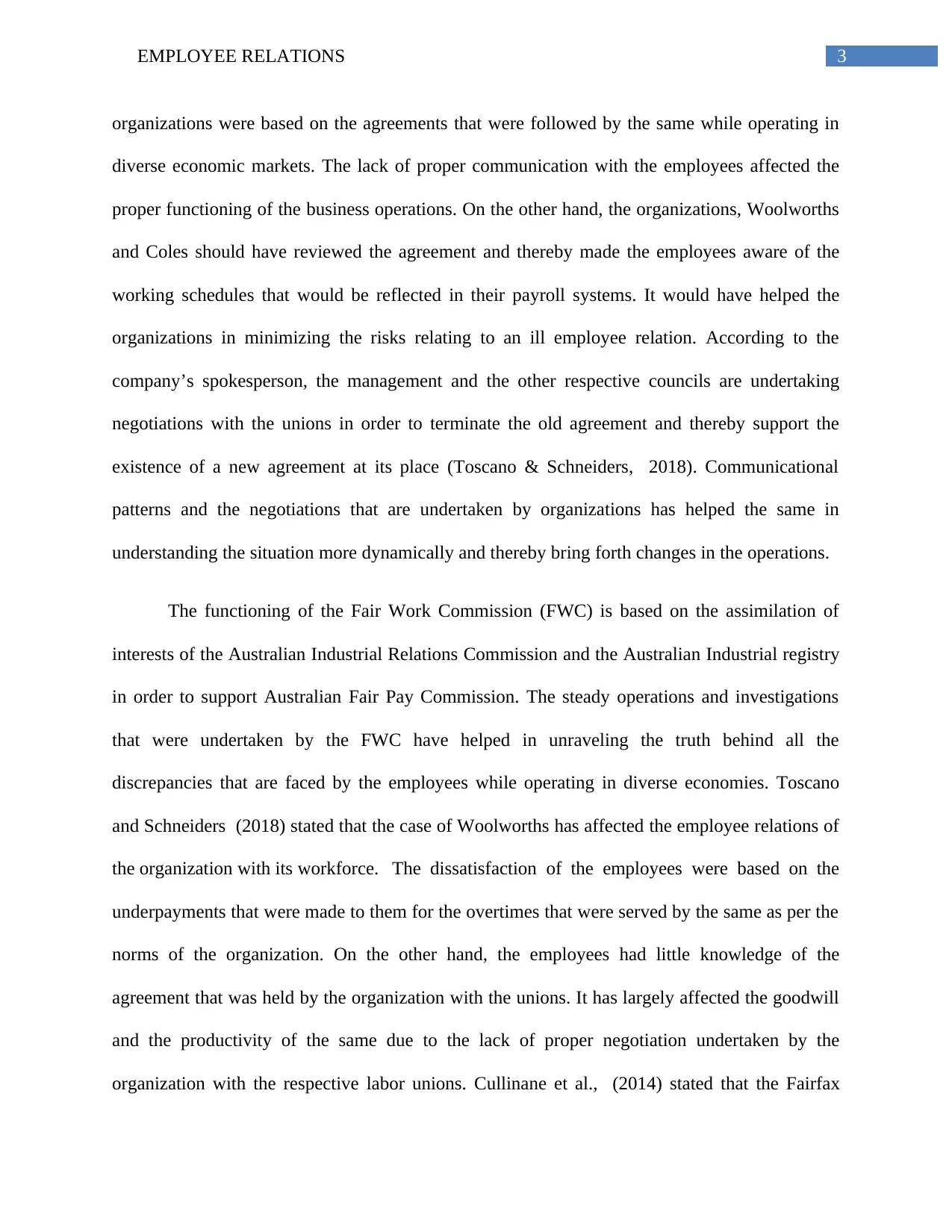
3EMPLOYEE RELATIONS
organizations were based on the agreements that were followed by the same while operating in
diverse economic markets. The lack of proper communication with the employees affected the
proper functioning of the business operations. On the other hand, the organizations, Woolworths
and Coles should have reviewed the agreement and thereby made the employees aware of the
working schedules that would be reflected in their payroll systems. It would have helped the
organizations in minimizing the risks relating to an ill employee relation. According to the
company’s spokesperson, the management and the other respective councils are undertaking
negotiations with the unions in order to terminate the old agreement and thereby support the
existence of a new agreement at its place (Toscano & Schneiders, 2018). Communicational
patterns and the negotiations that are undertaken by organizations has helped the same in
understanding the situation more dynamically and thereby bring forth changes in the operations.
The functioning of the Fair Work Commission (FWC) is based on the assimilation of
interests of the Australian Industrial Relations Commission and the Australian Industrial registry
in order to support Australian Fair Pay Commission. The steady operations and investigations
that were undertaken by the FWC have helped in unraveling the truth behind all the
discrepancies that are faced by the employees while operating in diverse economies. Toscano
and Schneiders (2018) stated that the case of Woolworths has affected the employee relations of
the organization with its workforce. The dissatisfaction of the employees were based on the
underpayments that were made to them for the overtimes that were served by the same as per the
norms of the organization. On the other hand, the employees had little knowledge of the
agreement that was held by the organization with the unions. It has largely affected the goodwill
and the productivity of the same due to the lack of proper negotiation undertaken by the
organization with the respective labor unions. Cullinane et al., (2014) stated that the Fairfax
organizations were based on the agreements that were followed by the same while operating in
diverse economic markets. The lack of proper communication with the employees affected the
proper functioning of the business operations. On the other hand, the organizations, Woolworths
and Coles should have reviewed the agreement and thereby made the employees aware of the
working schedules that would be reflected in their payroll systems. It would have helped the
organizations in minimizing the risks relating to an ill employee relation. According to the
company’s spokesperson, the management and the other respective councils are undertaking
negotiations with the unions in order to terminate the old agreement and thereby support the
existence of a new agreement at its place (Toscano & Schneiders, 2018). Communicational
patterns and the negotiations that are undertaken by organizations has helped the same in
understanding the situation more dynamically and thereby bring forth changes in the operations.
The functioning of the Fair Work Commission (FWC) is based on the assimilation of
interests of the Australian Industrial Relations Commission and the Australian Industrial registry
in order to support Australian Fair Pay Commission. The steady operations and investigations
that were undertaken by the FWC have helped in unraveling the truth behind all the
discrepancies that are faced by the employees while operating in diverse economies. Toscano
and Schneiders (2018) stated that the case of Woolworths has affected the employee relations of
the organization with its workforce. The dissatisfaction of the employees were based on the
underpayments that were made to them for the overtimes that were served by the same as per the
norms of the organization. On the other hand, the employees had little knowledge of the
agreement that was held by the organization with the unions. It has largely affected the goodwill
and the productivity of the same due to the lack of proper negotiation undertaken by the
organization with the respective labor unions. Cullinane et al., (2014) stated that the Fairfax
Paraphrase This Document
Need a fresh take? Get an instant paraphrase of this document with our AI Paraphraser
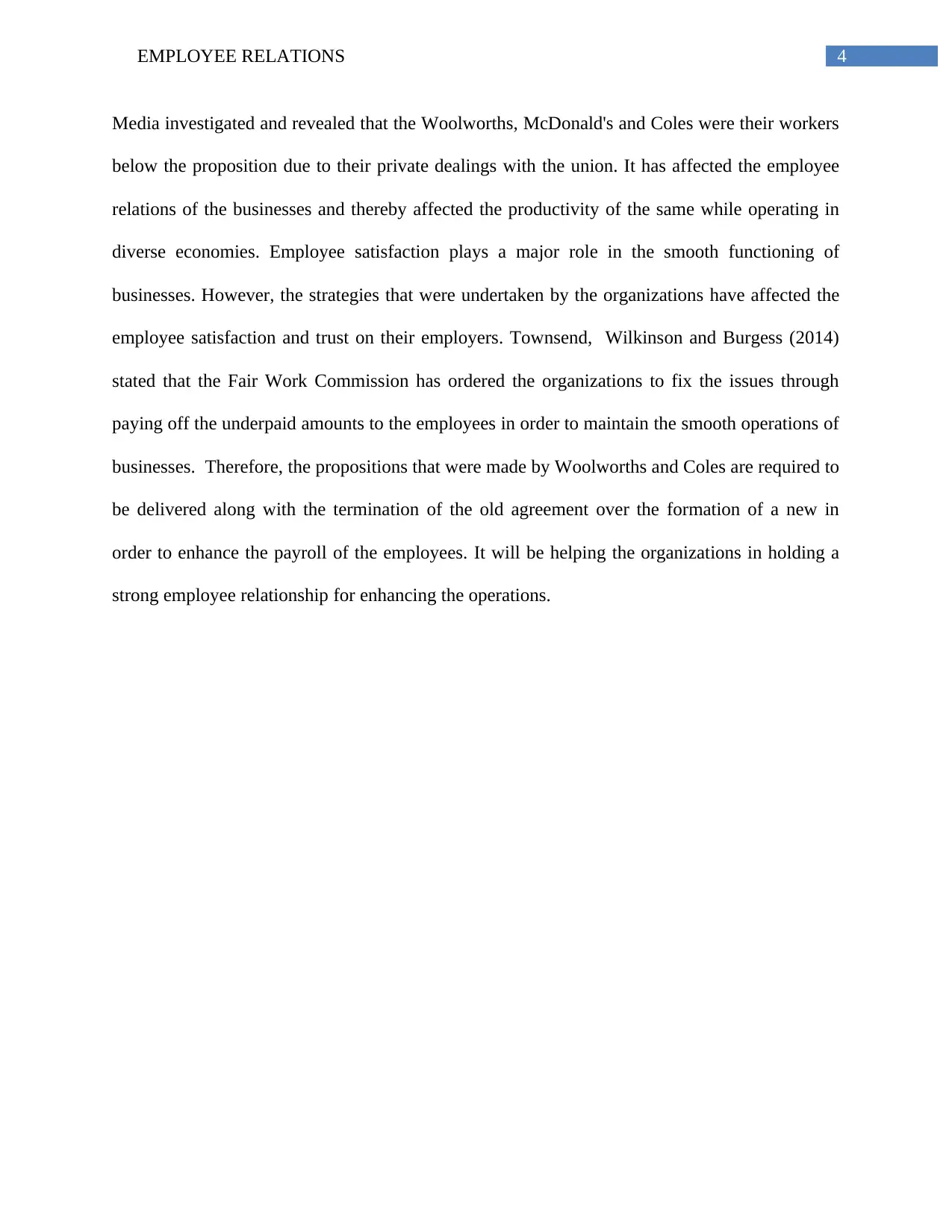
4EMPLOYEE RELATIONS
Media investigated and revealed that the Woolworths, McDonald's and Coles were their workers
below the proposition due to their private dealings with the union. It has affected the employee
relations of the businesses and thereby affected the productivity of the same while operating in
diverse economies. Employee satisfaction plays a major role in the smooth functioning of
businesses. However, the strategies that were undertaken by the organizations have affected the
employee satisfaction and trust on their employers. Townsend, Wilkinson and Burgess (2014)
stated that the Fair Work Commission has ordered the organizations to fix the issues through
paying off the underpaid amounts to the employees in order to maintain the smooth operations of
businesses. Therefore, the propositions that were made by Woolworths and Coles are required to
be delivered along with the termination of the old agreement over the formation of a new in
order to enhance the payroll of the employees. It will be helping the organizations in holding a
strong employee relationship for enhancing the operations.
Media investigated and revealed that the Woolworths, McDonald's and Coles were their workers
below the proposition due to their private dealings with the union. It has affected the employee
relations of the businesses and thereby affected the productivity of the same while operating in
diverse economies. Employee satisfaction plays a major role in the smooth functioning of
businesses. However, the strategies that were undertaken by the organizations have affected the
employee satisfaction and trust on their employers. Townsend, Wilkinson and Burgess (2014)
stated that the Fair Work Commission has ordered the organizations to fix the issues through
paying off the underpaid amounts to the employees in order to maintain the smooth operations of
businesses. Therefore, the propositions that were made by Woolworths and Coles are required to
be delivered along with the termination of the old agreement over the formation of a new in
order to enhance the payroll of the employees. It will be helping the organizations in holding a
strong employee relationship for enhancing the operations.
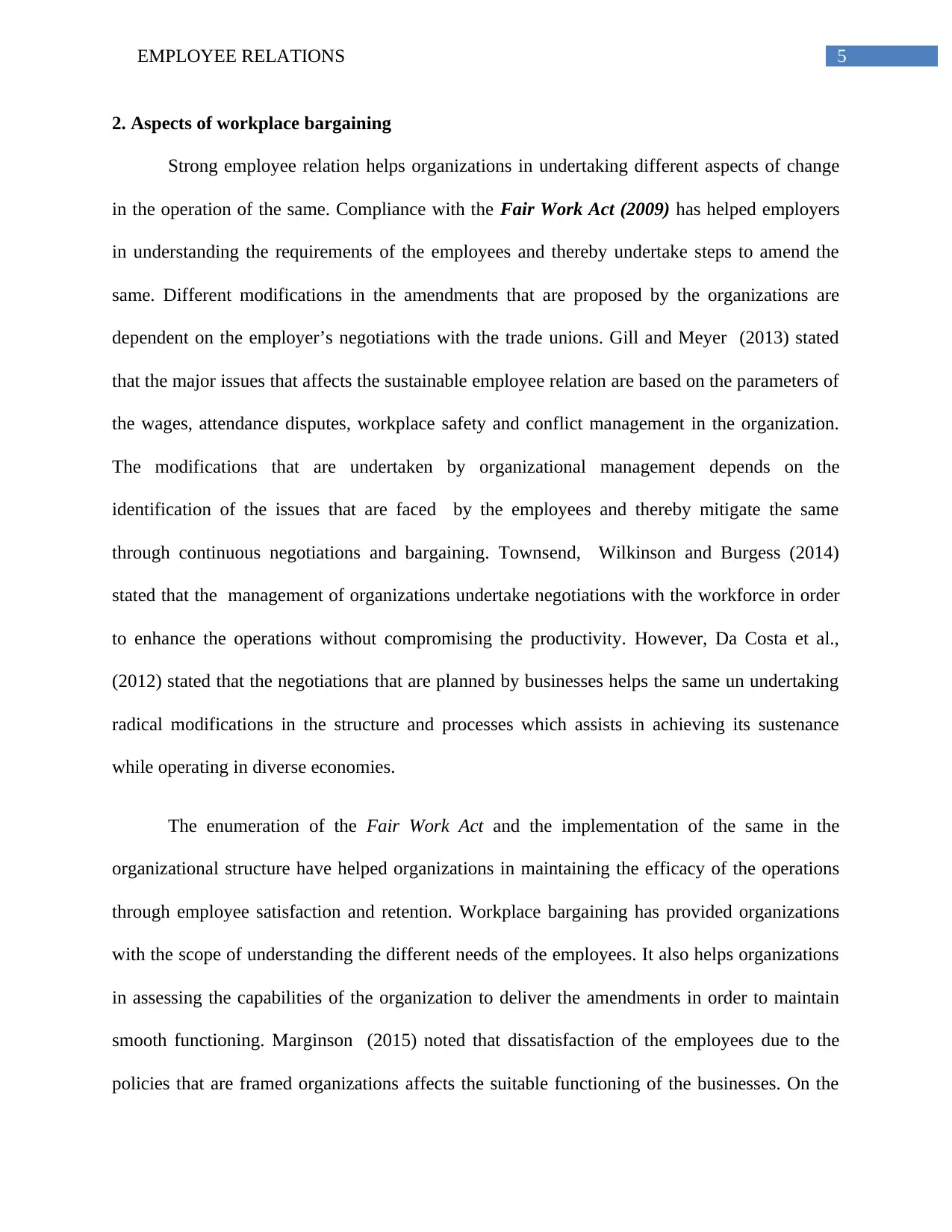
5EMPLOYEE RELATIONS
2. Aspects of workplace bargaining
Strong employee relation helps organizations in undertaking different aspects of change
in the operation of the same. Compliance with the Fair Work Act (2009) has helped employers
in understanding the requirements of the employees and thereby undertake steps to amend the
same. Different modifications in the amendments that are proposed by the organizations are
dependent on the employer’s negotiations with the trade unions. Gill and Meyer (2013) stated
that the major issues that affects the sustainable employee relation are based on the parameters of
the wages, attendance disputes, workplace safety and conflict management in the organization.
The modifications that are undertaken by organizational management depends on the
identification of the issues that are faced by the employees and thereby mitigate the same
through continuous negotiations and bargaining. Townsend, Wilkinson and Burgess (2014)
stated that the management of organizations undertake negotiations with the workforce in order
to enhance the operations without compromising the productivity. However, Da Costa et al.,
(2012) stated that the negotiations that are planned by businesses helps the same un undertaking
radical modifications in the structure and processes which assists in achieving its sustenance
while operating in diverse economies.
The enumeration of the Fair Work Act and the implementation of the same in the
organizational structure have helped organizations in maintaining the efficacy of the operations
through employee satisfaction and retention. Workplace bargaining has provided organizations
with the scope of understanding the different needs of the employees. It also helps organizations
in assessing the capabilities of the organization to deliver the amendments in order to maintain
smooth functioning. Marginson (2015) noted that dissatisfaction of the employees due to the
policies that are framed organizations affects the suitable functioning of the businesses. On the
2. Aspects of workplace bargaining
Strong employee relation helps organizations in undertaking different aspects of change
in the operation of the same. Compliance with the Fair Work Act (2009) has helped employers
in understanding the requirements of the employees and thereby undertake steps to amend the
same. Different modifications in the amendments that are proposed by the organizations are
dependent on the employer’s negotiations with the trade unions. Gill and Meyer (2013) stated
that the major issues that affects the sustainable employee relation are based on the parameters of
the wages, attendance disputes, workplace safety and conflict management in the organization.
The modifications that are undertaken by organizational management depends on the
identification of the issues that are faced by the employees and thereby mitigate the same
through continuous negotiations and bargaining. Townsend, Wilkinson and Burgess (2014)
stated that the management of organizations undertake negotiations with the workforce in order
to enhance the operations without compromising the productivity. However, Da Costa et al.,
(2012) stated that the negotiations that are planned by businesses helps the same un undertaking
radical modifications in the structure and processes which assists in achieving its sustenance
while operating in diverse economies.
The enumeration of the Fair Work Act and the implementation of the same in the
organizational structure have helped organizations in maintaining the efficacy of the operations
through employee satisfaction and retention. Workplace bargaining has provided organizations
with the scope of understanding the different needs of the employees. It also helps organizations
in assessing the capabilities of the organization to deliver the amendments in order to maintain
smooth functioning. Marginson (2015) noted that dissatisfaction of the employees due to the
policies that are framed organizations affects the suitable functioning of the businesses. On the
⊘ This is a preview!⊘
Do you want full access?
Subscribe today to unlock all pages.

Trusted by 1+ million students worldwide
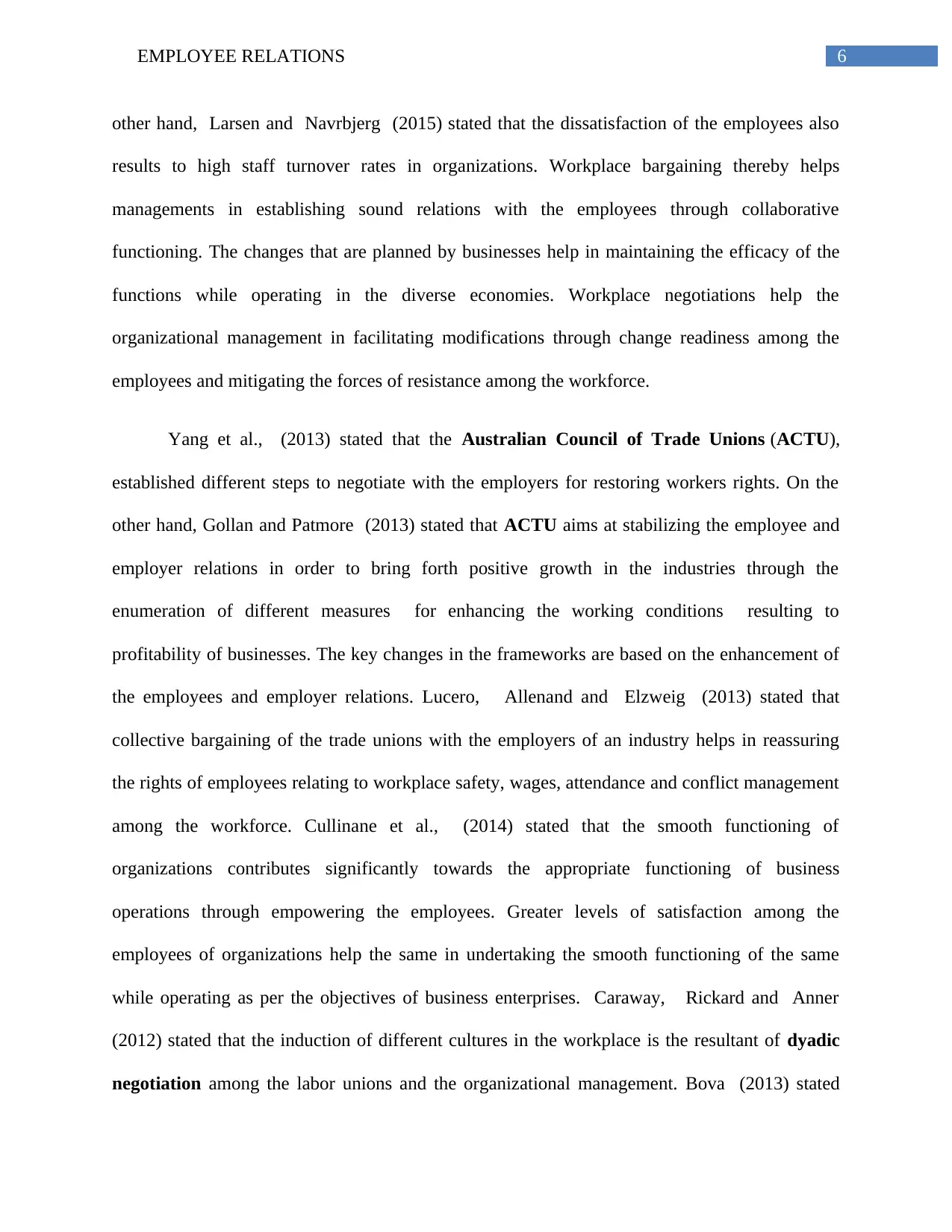
6EMPLOYEE RELATIONS
other hand, Larsen and Navrbjerg (2015) stated that the dissatisfaction of the employees also
results to high staff turnover rates in organizations. Workplace bargaining thereby helps
managements in establishing sound relations with the employees through collaborative
functioning. The changes that are planned by businesses help in maintaining the efficacy of the
functions while operating in the diverse economies. Workplace negotiations help the
organizational management in facilitating modifications through change readiness among the
employees and mitigating the forces of resistance among the workforce.
Yang et al., (2013) stated that the Australian Council of Trade Unions (ACTU),
established different steps to negotiate with the employers for restoring workers rights. On the
other hand, Gollan and Patmore (2013) stated that ACTU aims at stabilizing the employee and
employer relations in order to bring forth positive growth in the industries through the
enumeration of different measures for enhancing the working conditions resulting to
profitability of businesses. The key changes in the frameworks are based on the enhancement of
the employees and employer relations. Lucero, Allenand and Elzweig (2013) stated that
collective bargaining of the trade unions with the employers of an industry helps in reassuring
the rights of employees relating to workplace safety, wages, attendance and conflict management
among the workforce. Cullinane et al., (2014) stated that the smooth functioning of
organizations contributes significantly towards the appropriate functioning of business
operations through empowering the employees. Greater levels of satisfaction among the
employees of organizations help the same in undertaking the smooth functioning of the same
while operating as per the objectives of business enterprises. Caraway, Rickard and Anner
(2012) stated that the induction of different cultures in the workplace is the resultant of dyadic
negotiation among the labor unions and the organizational management. Bova (2013) stated
other hand, Larsen and Navrbjerg (2015) stated that the dissatisfaction of the employees also
results to high staff turnover rates in organizations. Workplace bargaining thereby helps
managements in establishing sound relations with the employees through collaborative
functioning. The changes that are planned by businesses help in maintaining the efficacy of the
functions while operating in the diverse economies. Workplace negotiations help the
organizational management in facilitating modifications through change readiness among the
employees and mitigating the forces of resistance among the workforce.
Yang et al., (2013) stated that the Australian Council of Trade Unions (ACTU),
established different steps to negotiate with the employers for restoring workers rights. On the
other hand, Gollan and Patmore (2013) stated that ACTU aims at stabilizing the employee and
employer relations in order to bring forth positive growth in the industries through the
enumeration of different measures for enhancing the working conditions resulting to
profitability of businesses. The key changes in the frameworks are based on the enhancement of
the employees and employer relations. Lucero, Allenand and Elzweig (2013) stated that
collective bargaining of the trade unions with the employers of an industry helps in reassuring
the rights of employees relating to workplace safety, wages, attendance and conflict management
among the workforce. Cullinane et al., (2014) stated that the smooth functioning of
organizations contributes significantly towards the appropriate functioning of business
operations through empowering the employees. Greater levels of satisfaction among the
employees of organizations help the same in undertaking the smooth functioning of the same
while operating as per the objectives of business enterprises. Caraway, Rickard and Anner
(2012) stated that the induction of different cultures in the workplace is the resultant of dyadic
negotiation among the labor unions and the organizational management. Bova (2013) stated
Paraphrase This Document
Need a fresh take? Get an instant paraphrase of this document with our AI Paraphraser
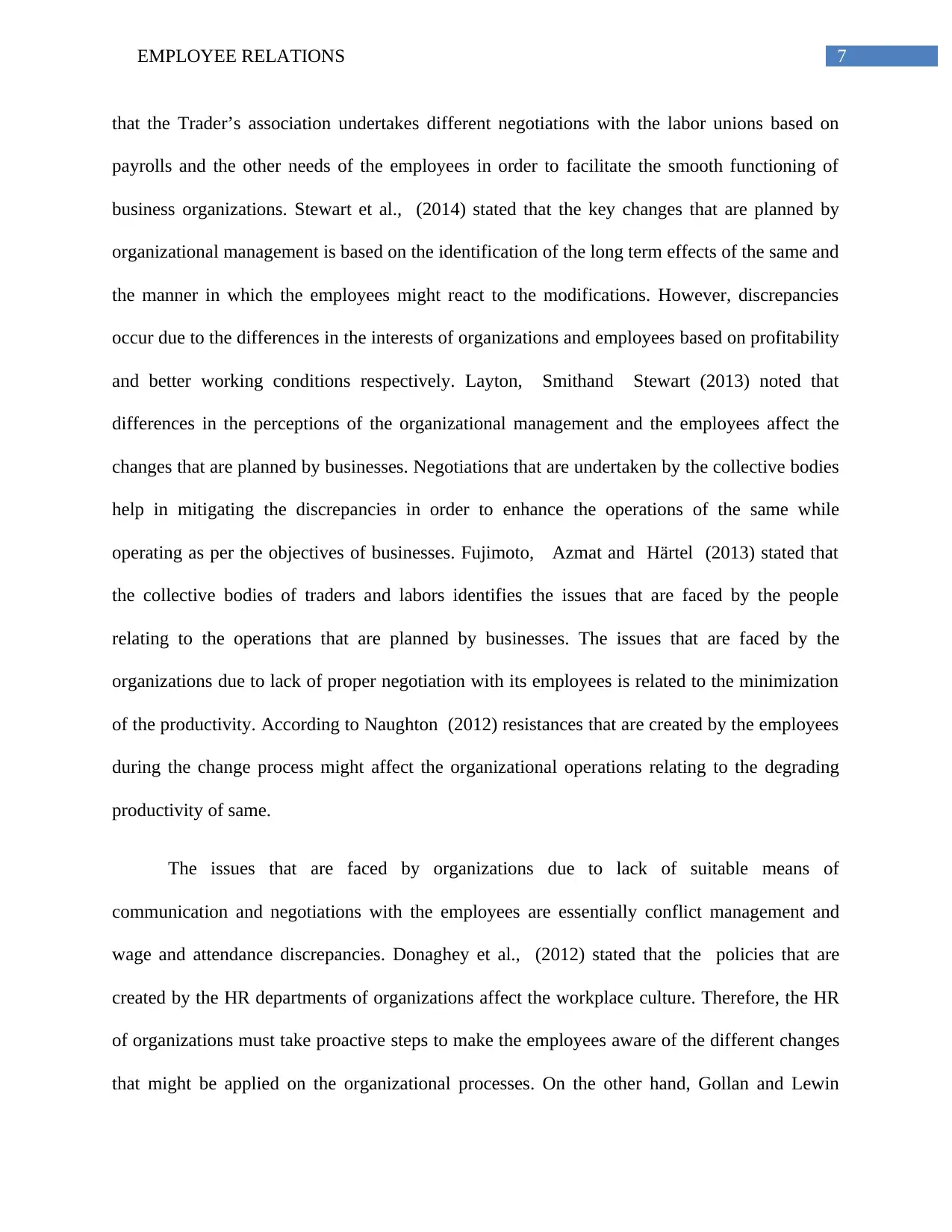
7EMPLOYEE RELATIONS
that the Trader’s association undertakes different negotiations with the labor unions based on
payrolls and the other needs of the employees in order to facilitate the smooth functioning of
business organizations. Stewart et al., (2014) stated that the key changes that are planned by
organizational management is based on the identification of the long term effects of the same and
the manner in which the employees might react to the modifications. However, discrepancies
occur due to the differences in the interests of organizations and employees based on profitability
and better working conditions respectively. Layton, Smithand Stewart (2013) noted that
differences in the perceptions of the organizational management and the employees affect the
changes that are planned by businesses. Negotiations that are undertaken by the collective bodies
help in mitigating the discrepancies in order to enhance the operations of the same while
operating as per the objectives of businesses. Fujimoto, Azmat and Härtel (2013) stated that
the collective bodies of traders and labors identifies the issues that are faced by the people
relating to the operations that are planned by businesses. The issues that are faced by the
organizations due to lack of proper negotiation with its employees is related to the minimization
of the productivity. According to Naughton (2012) resistances that are created by the employees
during the change process might affect the organizational operations relating to the degrading
productivity of same.
The issues that are faced by organizations due to lack of suitable means of
communication and negotiations with the employees are essentially conflict management and
wage and attendance discrepancies. Donaghey et al., (2012) stated that the policies that are
created by the HR departments of organizations affect the workplace culture. Therefore, the HR
of organizations must take proactive steps to make the employees aware of the different changes
that might be applied on the organizational processes. On the other hand, Gollan and Lewin
that the Trader’s association undertakes different negotiations with the labor unions based on
payrolls and the other needs of the employees in order to facilitate the smooth functioning of
business organizations. Stewart et al., (2014) stated that the key changes that are planned by
organizational management is based on the identification of the long term effects of the same and
the manner in which the employees might react to the modifications. However, discrepancies
occur due to the differences in the interests of organizations and employees based on profitability
and better working conditions respectively. Layton, Smithand Stewart (2013) noted that
differences in the perceptions of the organizational management and the employees affect the
changes that are planned by businesses. Negotiations that are undertaken by the collective bodies
help in mitigating the discrepancies in order to enhance the operations of the same while
operating as per the objectives of businesses. Fujimoto, Azmat and Härtel (2013) stated that
the collective bodies of traders and labors identifies the issues that are faced by the people
relating to the operations that are planned by businesses. The issues that are faced by the
organizations due to lack of proper negotiation with its employees is related to the minimization
of the productivity. According to Naughton (2012) resistances that are created by the employees
during the change process might affect the organizational operations relating to the degrading
productivity of same.
The issues that are faced by organizations due to lack of suitable means of
communication and negotiations with the employees are essentially conflict management and
wage and attendance discrepancies. Donaghey et al., (2012) stated that the policies that are
created by the HR departments of organizations affect the workplace culture. Therefore, the HR
of organizations must take proactive steps to make the employees aware of the different changes
that might be applied on the organizational processes. On the other hand, Gollan and Lewin
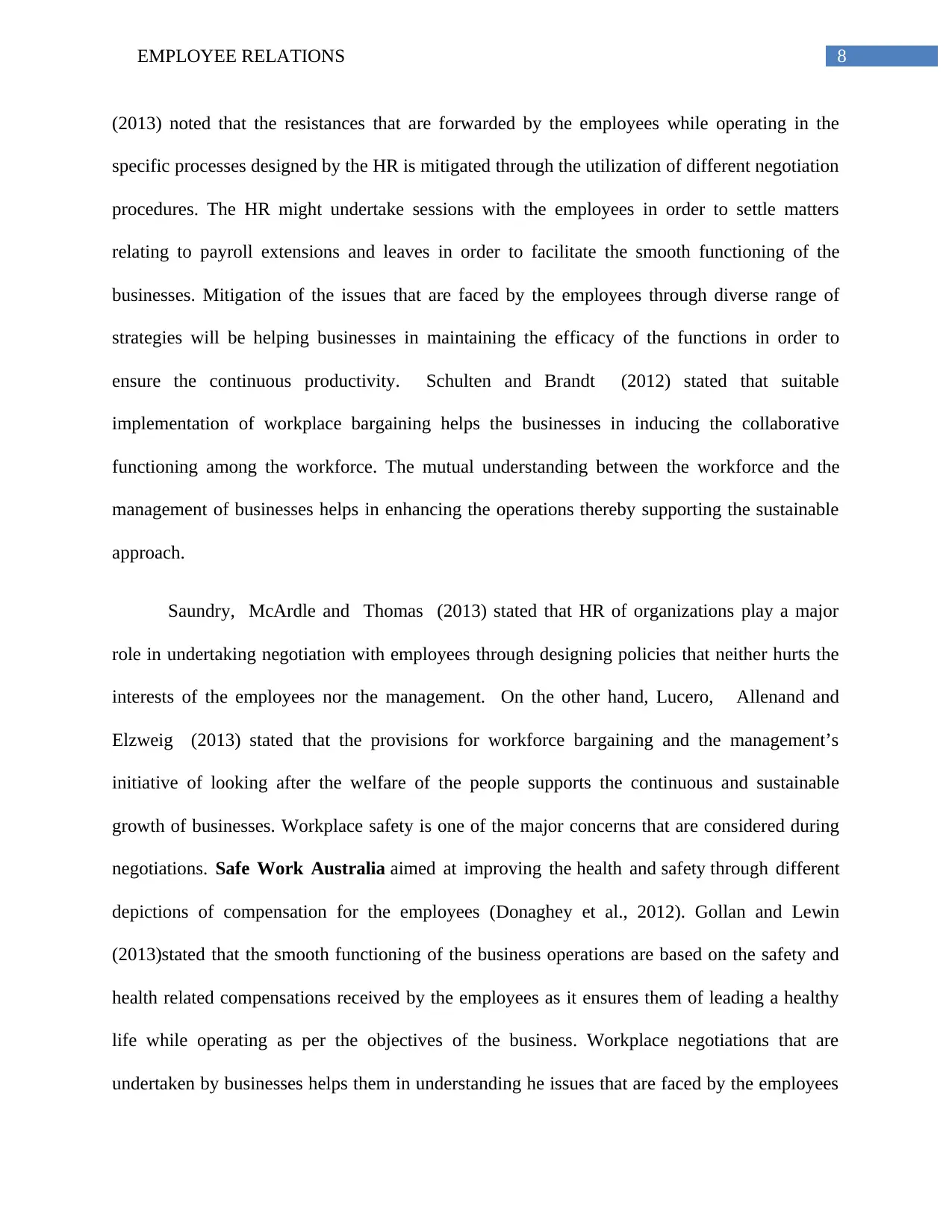
8EMPLOYEE RELATIONS
(2013) noted that the resistances that are forwarded by the employees while operating in the
specific processes designed by the HR is mitigated through the utilization of different negotiation
procedures. The HR might undertake sessions with the employees in order to settle matters
relating to payroll extensions and leaves in order to facilitate the smooth functioning of the
businesses. Mitigation of the issues that are faced by the employees through diverse range of
strategies will be helping businesses in maintaining the efficacy of the functions in order to
ensure the continuous productivity. Schulten and Brandt (2012) stated that suitable
implementation of workplace bargaining helps the businesses in inducing the collaborative
functioning among the workforce. The mutual understanding between the workforce and the
management of businesses helps in enhancing the operations thereby supporting the sustainable
approach.
Saundry, McArdle and Thomas (2013) stated that HR of organizations play a major
role in undertaking negotiation with employees through designing policies that neither hurts the
interests of the employees nor the management. On the other hand, Lucero, Allenand and
Elzweig (2013) stated that the provisions for workforce bargaining and the management’s
initiative of looking after the welfare of the people supports the continuous and sustainable
growth of businesses. Workplace safety is one of the major concerns that are considered during
negotiations. Safe Work Australia aimed at improving the health and safety through different
depictions of compensation for the employees (Donaghey et al., 2012). Gollan and Lewin
(2013)stated that the smooth functioning of the business operations are based on the safety and
health related compensations received by the employees as it ensures them of leading a healthy
life while operating as per the objectives of the business. Workplace negotiations that are
undertaken by businesses helps them in understanding he issues that are faced by the employees
(2013) noted that the resistances that are forwarded by the employees while operating in the
specific processes designed by the HR is mitigated through the utilization of different negotiation
procedures. The HR might undertake sessions with the employees in order to settle matters
relating to payroll extensions and leaves in order to facilitate the smooth functioning of the
businesses. Mitigation of the issues that are faced by the employees through diverse range of
strategies will be helping businesses in maintaining the efficacy of the functions in order to
ensure the continuous productivity. Schulten and Brandt (2012) stated that suitable
implementation of workplace bargaining helps the businesses in inducing the collaborative
functioning among the workforce. The mutual understanding between the workforce and the
management of businesses helps in enhancing the operations thereby supporting the sustainable
approach.
Saundry, McArdle and Thomas (2013) stated that HR of organizations play a major
role in undertaking negotiation with employees through designing policies that neither hurts the
interests of the employees nor the management. On the other hand, Lucero, Allenand and
Elzweig (2013) stated that the provisions for workforce bargaining and the management’s
initiative of looking after the welfare of the people supports the continuous and sustainable
growth of businesses. Workplace safety is one of the major concerns that are considered during
negotiations. Safe Work Australia aimed at improving the health and safety through different
depictions of compensation for the employees (Donaghey et al., 2012). Gollan and Lewin
(2013)stated that the smooth functioning of the business operations are based on the safety and
health related compensations received by the employees as it ensures them of leading a healthy
life while operating as per the objectives of the business. Workplace negotiations that are
undertaken by businesses helps them in understanding he issues that are faced by the employees
⊘ This is a preview!⊘
Do you want full access?
Subscribe today to unlock all pages.

Trusted by 1+ million students worldwide
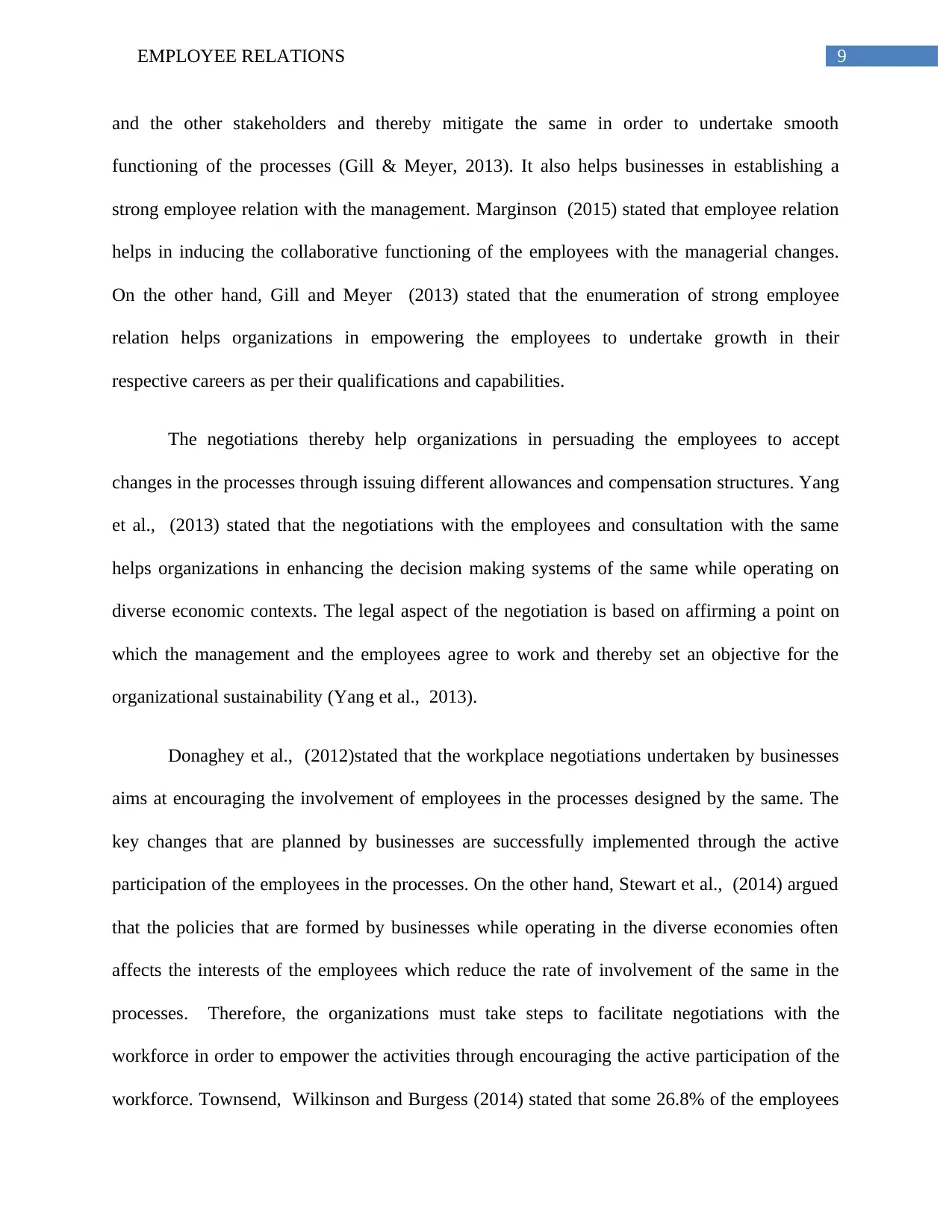
9EMPLOYEE RELATIONS
and the other stakeholders and thereby mitigate the same in order to undertake smooth
functioning of the processes (Gill & Meyer, 2013). It also helps businesses in establishing a
strong employee relation with the management. Marginson (2015) stated that employee relation
helps in inducing the collaborative functioning of the employees with the managerial changes.
On the other hand, Gill and Meyer (2013) stated that the enumeration of strong employee
relation helps organizations in empowering the employees to undertake growth in their
respective careers as per their qualifications and capabilities.
The negotiations thereby help organizations in persuading the employees to accept
changes in the processes through issuing different allowances and compensation structures. Yang
et al., (2013) stated that the negotiations with the employees and consultation with the same
helps organizations in enhancing the decision making systems of the same while operating on
diverse economic contexts. The legal aspect of the negotiation is based on affirming a point on
which the management and the employees agree to work and thereby set an objective for the
organizational sustainability (Yang et al., 2013).
Donaghey et al., (2012)stated that the workplace negotiations undertaken by businesses
aims at encouraging the involvement of employees in the processes designed by the same. The
key changes that are planned by businesses are successfully implemented through the active
participation of the employees in the processes. On the other hand, Stewart et al., (2014) argued
that the policies that are formed by businesses while operating in the diverse economies often
affects the interests of the employees which reduce the rate of involvement of the same in the
processes. Therefore, the organizations must take steps to facilitate negotiations with the
workforce in order to empower the activities through encouraging the active participation of the
workforce. Townsend, Wilkinson and Burgess (2014) stated that some 26.8% of the employees
and the other stakeholders and thereby mitigate the same in order to undertake smooth
functioning of the processes (Gill & Meyer, 2013). It also helps businesses in establishing a
strong employee relation with the management. Marginson (2015) stated that employee relation
helps in inducing the collaborative functioning of the employees with the managerial changes.
On the other hand, Gill and Meyer (2013) stated that the enumeration of strong employee
relation helps organizations in empowering the employees to undertake growth in their
respective careers as per their qualifications and capabilities.
The negotiations thereby help organizations in persuading the employees to accept
changes in the processes through issuing different allowances and compensation structures. Yang
et al., (2013) stated that the negotiations with the employees and consultation with the same
helps organizations in enhancing the decision making systems of the same while operating on
diverse economic contexts. The legal aspect of the negotiation is based on affirming a point on
which the management and the employees agree to work and thereby set an objective for the
organizational sustainability (Yang et al., 2013).
Donaghey et al., (2012)stated that the workplace negotiations undertaken by businesses
aims at encouraging the involvement of employees in the processes designed by the same. The
key changes that are planned by businesses are successfully implemented through the active
participation of the employees in the processes. On the other hand, Stewart et al., (2014) argued
that the policies that are formed by businesses while operating in the diverse economies often
affects the interests of the employees which reduce the rate of involvement of the same in the
processes. Therefore, the organizations must take steps to facilitate negotiations with the
workforce in order to empower the activities through encouraging the active participation of the
workforce. Townsend, Wilkinson and Burgess (2014) stated that some 26.8% of the employees
Paraphrase This Document
Need a fresh take? Get an instant paraphrase of this document with our AI Paraphraser
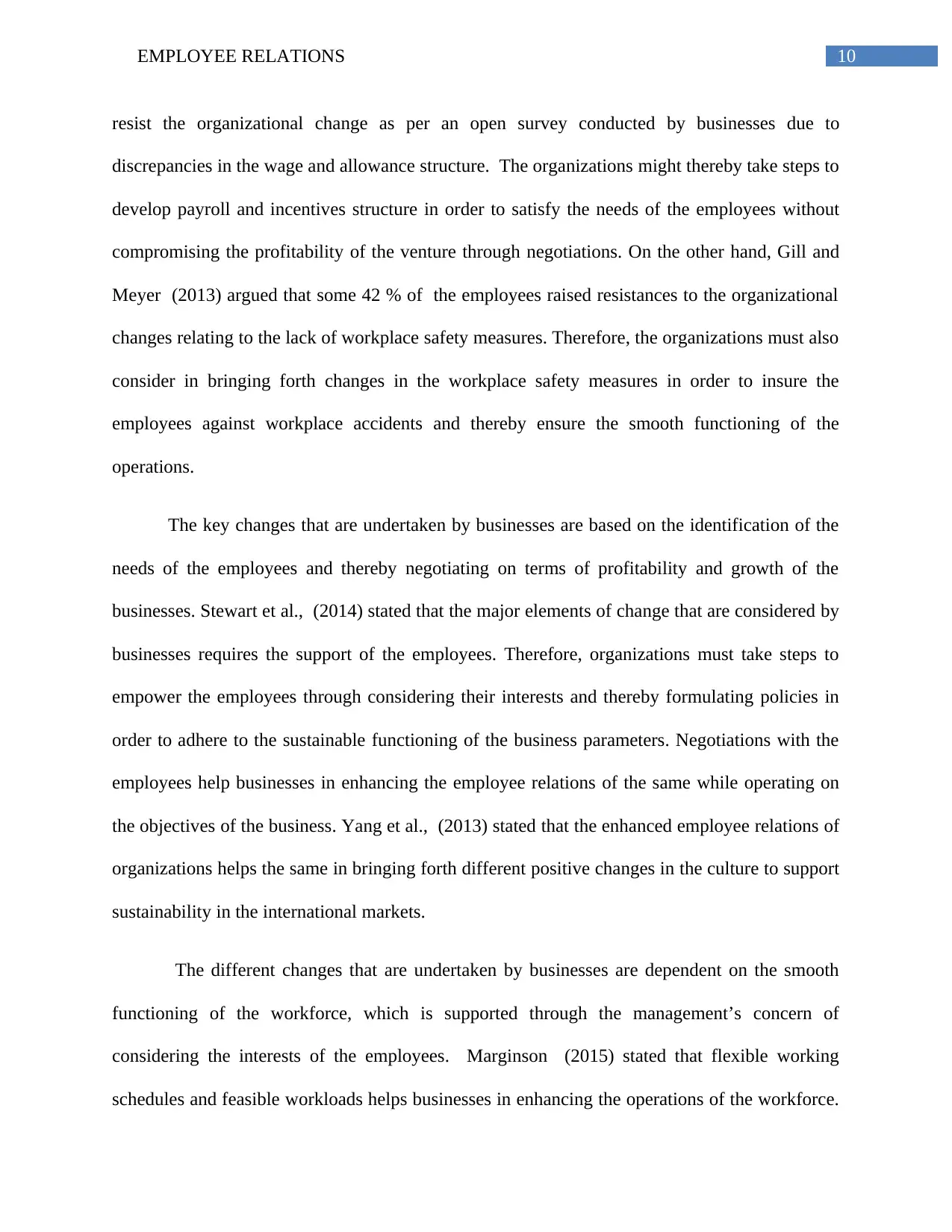
10EMPLOYEE RELATIONS
resist the organizational change as per an open survey conducted by businesses due to
discrepancies in the wage and allowance structure. The organizations might thereby take steps to
develop payroll and incentives structure in order to satisfy the needs of the employees without
compromising the profitability of the venture through negotiations. On the other hand, Gill and
Meyer (2013) argued that some 42 % of the employees raised resistances to the organizational
changes relating to the lack of workplace safety measures. Therefore, the organizations must also
consider in bringing forth changes in the workplace safety measures in order to insure the
employees against workplace accidents and thereby ensure the smooth functioning of the
operations.
The key changes that are undertaken by businesses are based on the identification of the
needs of the employees and thereby negotiating on terms of profitability and growth of the
businesses. Stewart et al., (2014) stated that the major elements of change that are considered by
businesses requires the support of the employees. Therefore, organizations must take steps to
empower the employees through considering their interests and thereby formulating policies in
order to adhere to the sustainable functioning of the business parameters. Negotiations with the
employees help businesses in enhancing the employee relations of the same while operating on
the objectives of the business. Yang et al., (2013) stated that the enhanced employee relations of
organizations helps the same in bringing forth different positive changes in the culture to support
sustainability in the international markets.
The different changes that are undertaken by businesses are dependent on the smooth
functioning of the workforce, which is supported through the management’s concern of
considering the interests of the employees. Marginson (2015) stated that flexible working
schedules and feasible workloads helps businesses in enhancing the operations of the workforce.
resist the organizational change as per an open survey conducted by businesses due to
discrepancies in the wage and allowance structure. The organizations might thereby take steps to
develop payroll and incentives structure in order to satisfy the needs of the employees without
compromising the profitability of the venture through negotiations. On the other hand, Gill and
Meyer (2013) argued that some 42 % of the employees raised resistances to the organizational
changes relating to the lack of workplace safety measures. Therefore, the organizations must also
consider in bringing forth changes in the workplace safety measures in order to insure the
employees against workplace accidents and thereby ensure the smooth functioning of the
operations.
The key changes that are undertaken by businesses are based on the identification of the
needs of the employees and thereby negotiating on terms of profitability and growth of the
businesses. Stewart et al., (2014) stated that the major elements of change that are considered by
businesses requires the support of the employees. Therefore, organizations must take steps to
empower the employees through considering their interests and thereby formulating policies in
order to adhere to the sustainable functioning of the business parameters. Negotiations with the
employees help businesses in enhancing the employee relations of the same while operating on
the objectives of the business. Yang et al., (2013) stated that the enhanced employee relations of
organizations helps the same in bringing forth different positive changes in the culture to support
sustainability in the international markets.
The different changes that are undertaken by businesses are dependent on the smooth
functioning of the workforce, which is supported through the management’s concern of
considering the interests of the employees. Marginson (2015) stated that flexible working
schedules and feasible workloads helps businesses in enhancing the operations of the workforce.
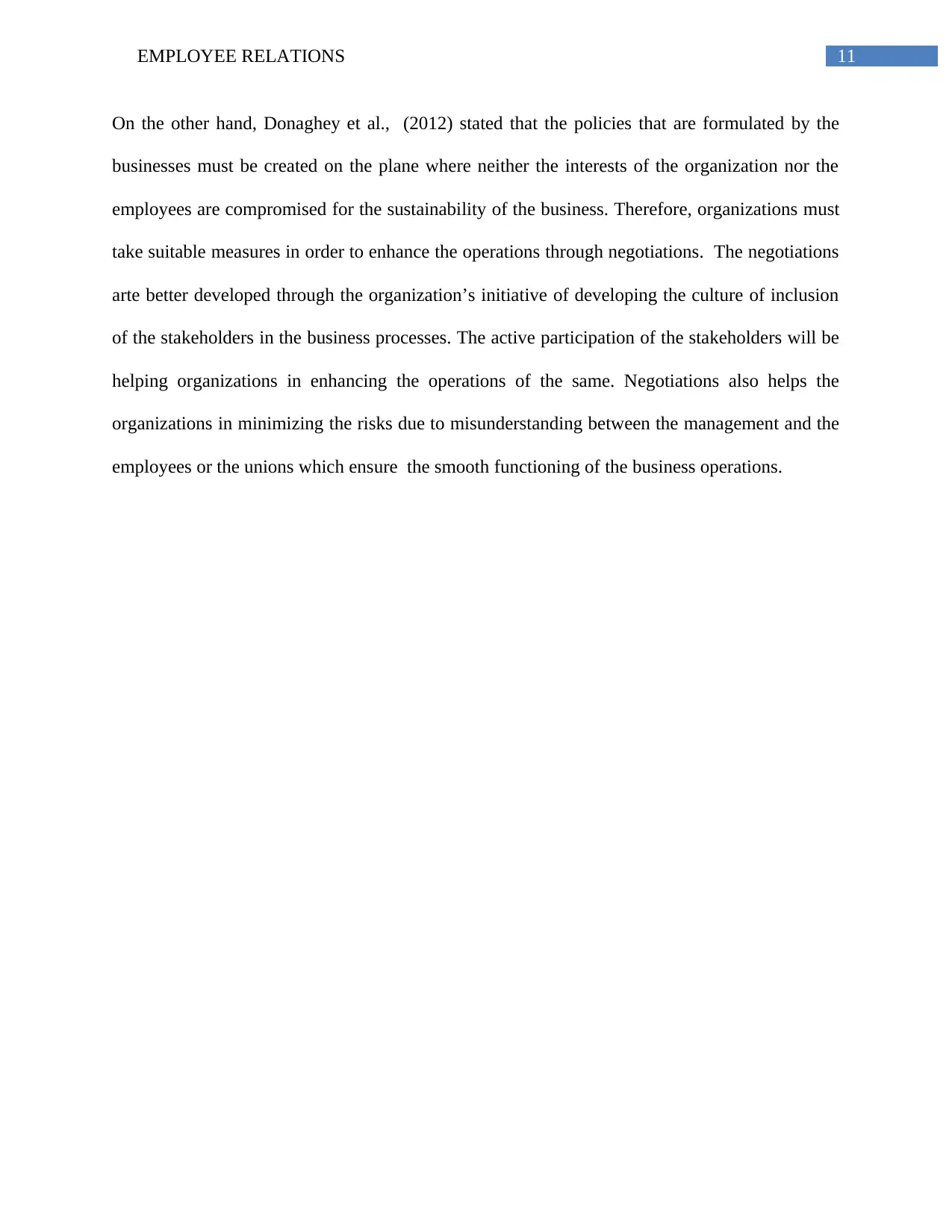
11EMPLOYEE RELATIONS
On the other hand, Donaghey et al., (2012) stated that the policies that are formulated by the
businesses must be created on the plane where neither the interests of the organization nor the
employees are compromised for the sustainability of the business. Therefore, organizations must
take suitable measures in order to enhance the operations through negotiations. The negotiations
arte better developed through the organization’s initiative of developing the culture of inclusion
of the stakeholders in the business processes. The active participation of the stakeholders will be
helping organizations in enhancing the operations of the same. Negotiations also helps the
organizations in minimizing the risks due to misunderstanding between the management and the
employees or the unions which ensure the smooth functioning of the business operations.
On the other hand, Donaghey et al., (2012) stated that the policies that are formulated by the
businesses must be created on the plane where neither the interests of the organization nor the
employees are compromised for the sustainability of the business. Therefore, organizations must
take suitable measures in order to enhance the operations through negotiations. The negotiations
arte better developed through the organization’s initiative of developing the culture of inclusion
of the stakeholders in the business processes. The active participation of the stakeholders will be
helping organizations in enhancing the operations of the same. Negotiations also helps the
organizations in minimizing the risks due to misunderstanding between the management and the
employees or the unions which ensure the smooth functioning of the business operations.
⊘ This is a preview!⊘
Do you want full access?
Subscribe today to unlock all pages.

Trusted by 1+ million students worldwide
1 out of 16
Related Documents
Your All-in-One AI-Powered Toolkit for Academic Success.
+13062052269
info@desklib.com
Available 24*7 on WhatsApp / Email
![[object Object]](/_next/static/media/star-bottom.7253800d.svg)
Unlock your academic potential
Copyright © 2020–2025 A2Z Services. All Rights Reserved. Developed and managed by ZUCOL.





